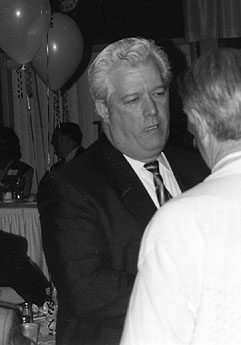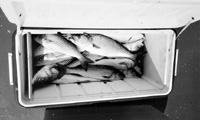
Dock of the Bay

Volume VI Number 39
October 1-7, 1998
Schools Rule in Jaycees A.A.
County Exec. Debate
Call it the John and Janet Show. The people of Anne Arundel County can see plenty of reruns between now and November if County Executive John Gary and his Democratic challenger, Janet Owens, keep to the rigorous debating schedule being offered.
"Almost every night, it seems like someone wants us to debate," said Gary, shaking his head.
"You'll be seeing more of me than Ruthanne," remarked Owens, referring to Gary's wife.
We'll have to see what familiarity does to the relationship between Gary, who can be grumpy, and Owens, the upset Democratic primary victor. And, of course, we'll have to see if voters who turn out get their money's worth.
Judging by the Jaycees-sponsored debate in Annapolis this week, people may be trading an evening with the family for a clash of opinions on the health of Anne Arundel schools.
Unless things change, they'll see Gary barely able to contain his anger at the county officials with whom he has been warring over money and accountability.
And they'll see Owens trying to make education policy a key issue but leaving the impression that she's still grasping for ways to draw distinctions between herself and the man she hopes to replace.
A modest gathering of 100 people turned out on Monday night at Maryland
Hall for the Creative Arts to see a 90-minute Gary-Owens debate, which was
sponsored by the Jaycees and moderated by New Bay Times general manager
J. Alex Knoll. The tenor was civil and the main topic education.
The candidates sparred over the adequacy of school funding, the building maintenance backlog and the deteriorating relationship between county government and school administrators. At times, audience members wondered if the debaters were talking about the same schools.
Speaking of building maintenance needs, Owens said: "If we don't get a handle on this, I can't imagine what our future is going to be."
Later, referring to Gary's fights with school administrators, she said: "When you tear down a public school system, it takes years to build it back up."
Gary's disputes with school administrators are well known, and he took pains during the debate to cast them as an effort on behalf of taxpayers to demand accountability from a bureaucracy that shows little of it. He professed astonishment, for instance, at reports that teachers in some schools are unable to make photocopies.
"Explain to me why I raise their budget from $6 million to $10.5 million [in that category] and they are telling teachers they don't have enough money to make copies. It doesn't make sense," he said.
Owens insisted that the percentage of the county budget devoted to education had declined under Gary. But Gary argued that those numbers are deceptive because his administration has needed to make large expenditures on a new courthouse, jail spending, 100 new county police officers and 36 new firefighters.
"You need to know your facts," he said to Owens. "You can't just shoot from the hip and make statements like that."
At one point, Gary apologized for a "Freudian slip" when he referred to his challenger as Ms Evans. Owens defeated Diane Evans, the Republican-turned-Democrat who had been expected to hold Gary's feet to the fire on development and environmental topics.
But in this debate, Owens made only one fleeting reference to the Chesapeake Bay, choosing instead to speak generally about growth management. "You only have to drive from one end of the county to the other to know that we are snarled in traffic, congestion and uncontrolled growth," she said, reading from a statement.
Because of that congestion, Owens said that she would champion no new road projects because new roads attract new people. She also said that the county ought to work toward attracting high-tech business as a growth management tool.
Gary asserted that the county's planning initiative had given citizens a prominent role in deciding where future growth takes place. He asserted that there are good paying jobs and benefits to the county in businesses that aren't classified as high-tech, such as auto-body repair.
And after hearing so much about education policy, audience members probably agreed with Gary when he asserted toward the end of the debate: "Ladies and gentlemen, there's more to running the government than the education system."
-BL
An Ideal Day on the Bay: Wish You Were There
Indian summer, and the livin' is easy. Fish were
jumpin'
Fish were jumping into the seven boats carrying the New Bay Times-Bill Burton Third Annual Forget Football - Go Fishing trip onto the waters of Chesapeake Bay.
Tracked down by salty captains consulting top-gun radar screens, lured by a soup of chum, hooked on a tasty bait of raw fish, soft clams and occasional chunks of soft crab, the fish came big, fat and frequent. Rockfish, bluefish, flounder, even toadfish and rays: they couldn't resist us.
Even on Chesapeake Bay, a day like September 27, 1998 is remarkable.
Five of the seven boats caught their limits of two rockfish per fisherman, often before noon. The biggest, caught by 15-year-old Jonathan Lawrence of Pasadena, measured 28 inches. A hair's breadth shorter at 27 34" was the runner-up, caught by Lois Burton, wife of Bill Burton, our commodore and old man of Chesapeake seas.
"The Lord smiles on those who don't go to Sunday football," said Burton.
Feisty, tasty rockfish, arguably more abundant than ever, were the catch
of the day. But that didn't keep a few wild cards off the line. Bluefish,
a fighter that's especially tasty when smoked, took some of the same bait.
Some boats, reaching their limits early, trolled for blues with bright colored
surgical hoses.
photo by Mark BurnsJonathan Lawrence, center, with Bill Burton and Alex Knoll, won the award for biggest catch of the day, a 28" rocksfish.
Toadfish? You seldom go out looking for those warty little monsters, but you catch them all the same. (Even Burton boated one; we're saving that photo for a future cover.) Stingrays, too, are no catch of choice; they feel like a cement bucket on your line, but when you've hooked one, you share a moment with a wonder of the deep.
You didn't have to work particularly hard to catch these fish. With captains
to stalk them and mates to bait the hooks and dehook the catch (assuring
the returned fish lived to catch another day), this was lazy people's fishing
at its best. All you had to do was park your rod and look alert; failing
that, a shipmate was sure to call out when your rod bent with a strike.
Still, some worked at it. On the Buddy Plan, skippered by the master of the fleet himself, Captain Buddy Harrison, Lois Burton, Calvin Bregel of Baltimore and Stan Minken of Owings Mills staked out the stern of the boat most of seven hours to prove Bregel's oft-repeated assurances that "you catch twice as many fish off the back of the boat."
But if you felt like lounging in the sun, well, the fish practically jumped into your lap.
photo by Mark Burns Ron Smith kicks back on the Bay in between catching fish.
Even if you didn't care to fish - or, worse, like Kevin Litkowski, caught only a branch - this was a day to savor. Indian summer irresistibly reminded all aboard of what we're about to lose. Doing its best to prolong the season, the day shimmered with sun, reaching the mid-90s. The Bay sparked and gently rolled. (For at least one would-be fisherman, this was not a plus. If you're not certain of your sea legs, he learned, you better use a pill, a patch or a bracelet.) Balloon spinnakers brilliant, hundreds of sailboats crept up the Bay in the annual Annapolis-Oxford race.
"It's been a very relaxing trip. Even if I didn't catch fish, it would be well worth the money," said Ron Smith, one of a party of five union plumbers who work in the coordinating office of John J. Kirlin Inc. of Washington, D.C.
Read this and remember. Friends and readers of New Bay Times return to the water next year on the last Sunday in September. We give plenty of advance notice in these pages. See you next year.
-SOM
Friend, Can You Spare an Iris?
When Sharon Carey met Bruce Hornstein, it was a match made in heaven.
Carey sought irises.
Hornstein had irises. Lots of them.
Together with a group of school children - and possibly a little help from you - they'll stock the Maryland Iris Garden at the Maryland Historical Society's Mount Vernon campus in Baltimore city. The landscaping project is a cooperative effort between the historical society and its neighbor, Grace and St. Peter's Episcopal elementary school.
The Maryland Iris Garden is the brainchild of Carey, who teaches art at the Baltimore school. Carey aims to create entertaining and meaningful ways for kids to learn. This iris garden will serve as a "living classroom" for Carey's students, providing hands-on experience with the art and science of the natural world as they plant the garden and watch it grow. Later, she envisions her students planting gardens in other parts of the city.
Carey also aspires to symbolize Maryland's variegated community by gathering a bit of Baltimore and all 23 counties into this garden. Each, she hopes, will be represented by at least one iris. "The American Iris Society has offered to donate plants, but we prefer the garden to be a community effort," Carey explains. "Variety is the spirit of the project."
That's where you come in. "Send irises - plain or fancy," says Carey. Every iris that she receives will find its way into the garden. Ceramic plaques, crafted by her students at the school, will identify each iris plant, its donor and the county it represents.
"The idea is just wonderful. It's good for the city," says the delighted Hornstein, a Baltimore city native.
An iris grower and American Iris Society judge for cut-flower competitions, Dr. L. Bruce Hornstein cultivates 10,000 different named varieties (known as "cultivars") of irises at his very own Sans Souci Nursery in Monkton. Since retiring from his 40-year career as a veterinarian in 1996, this life-long flower enthusiast devotes his time to growing cannas, dahlias and peonies as well as all those irises.
Hornstein heard about the iris garden project from a friend and happily
donated four different species of iris plants to represent Harford County.
photo Kim Cammarata Bruce Hornstein with irises, and here, dahlias.
Iris are classified by The American Iris Society into three main groups: Bearded irises, beardless irises and aril irises. (Aril Irises grow only in warm and dry regions, such as the American Southwest.) While Carey will gladly accept any type of Maryland-grown iris, she particularly wants bearded irises because they will more easily survive the heat of the city.
Iris expert Hornstein concurs: "Bearded irises are drought resistant and need six to eight hours of full sun during the day." In fact, if bearded irises get too much water, they'll rot, so they must be planted in well-drained soil. Beardless irises, on the other hand, thrive in moister conditions.
"Irises have been popular for a long time," says Hornstein. He adds that bearded irises originated in Europe and Asia Minor; none are native to North America. Ancient Greeks carried irises with them on their travels, using the ground-up roots as perfume. In this way, they spread them all over the Mediterranean region.
In Greek mythology, Hornstein reminds us, Iris was the goddess of the
rainbow, and the Greek word iris means colors of the rainbow. Bearded irises
live up to their name in late spring by producing large, showy blooms in
a staggering array of colors. Except, according to Hornstein, pure red.
These beautiful bearded iris blooms inspired Carey's choice of the plant for this project. "I chose irises because the color and size [of the flowers] appeal to young children," she said.
As a bonus, some bearded irises are "rebloomers," which flower not only in the spring but again in late September to early October. When the weather is unusually mild, Hornstein has seen his rebloomers flower as late as early November.
The bearded iris blossoms have three petals that stand up called "standards" and three petals that hang down called "falls." They are distinguished from the other classes of irises by thick, fuzzy projections, or "beards," in the middle of each of the three falls.
Each beard has pollen stored behind it, and bees land there. But plant scientists don't fully understand the function of these beards. According to Hornstein, horticulturists often joke that "The beard is where the bees wipe the pollen off their feet."
Bearded irises grow from "rhizomes," a thick fleshy root that looks similar to a small potato. Plant iris rhizomes shallowly with the top surface exposed to the sun. Make sure the clipped leaves face the sky and the smaller roots orient toward the earth.
In the Middle Bay area, bearded iris rhizomes can be planted from May to Oct. 15, according to Hornstein. Now is just about ideal. But, he warns, "Don't put them in the ground too late or the freeze/thaw cycle may heave them out."
These rhizomes grow and spread underground, which is why Hornstein advises not to crowd them into a flower bed. Even so, after a few years the new rhizomes must be dug up and replanted elsewhere. It is these rhizomes that Carey seeks for the Maryland Iris Garden.
Next spring, Carey's students from Grace and St. Peter's will plant the donated irises; then they'll watch them grow and bloom each spring.
Carey conceived the iris garden after her students completed a similar project last year, planting daffodil bulbs on the grounds of Enoch Pratt Central Library. That bulb project, like the Maryland Iris Garden effort, is part of the "art-science" education curriculum that Carey developed in which art and science studies coordinate and reinforce each other.
"Educators need to increase science studies at the elementary level. Because scientific principles are usually incorporated in various forms of art, a very natural connection exists between art and science," explains the veteran educator.
Carey says she has received irises from about 16 counties so far, all of them different. Hornstein, too, is glad to see Marylanders participating in this effort: "It shows there are people who care about our children and care about our future."
Send your iris donations for the Maryland Iris Garden, information about the irises and your garden and a photo to Sharon Carey, Maryland Iris Garden, Grace and St. Peter's School, 707 Park Ave., Baltimore, Md. 21201. 410/539-1395.
To learn more about irises, reach Hornstein at 410/557-0250 or check out the American Iris Society's homepage (which also includes pictures of many varieties of irises): www.isomedia.com/homes/AIS
-Kim Cammarata
In Washington, the Interior Department,
the National Wildlife Federation and creators of the
television series "Kratt's Creatures" announced a new partnership
last week called Frog Force. With a new website (www.frogweb.gov) and advertising, the goal
is to protect frogs and understand why there are fewer of them these days
In California, an Eagle Scout received $500 for finding the "weirdest thing" during the International Coastal Cleanup day. In an airtight container, he found a letter from a Ukrainian sailor desperately seeking an American pen pal, the San Francisco Examiner reports. The sailor apologized for creating pollution but said he didn't want to die without making a friend ...
Our Creature Feature is a tale from Florida, where alligator season is underway. The Miami Herald reports that two fellows named Ayers and Gilliam thought they were doing well when they bagged an 11-foot long alligator on opening day in Lake Okeechobee. Any gators 18 inches or longer are fair game this month.
But then in the dark they saw the monster: shining, ruby red eyes two feet apart on a head the size of a coffee table. They readied their weapon, a .44 magnum bangstick - an explosive charge on the end of a pole - but the spear bounced off like it was steel. They did it again and again, but it wouldn't penetrate the hide of a giant gator that might have been over 15 feet long.
The disconsolate gator hunters headed home but had one more surprise: They barely escaped injury when the 11-footer came back to life and began thrashing around in their small boat.
Update: More on the Movie Our Bay Sent Packing
You'll remember that New Bay Times reported this spring that Warner Brothers had fled to New England in search of a location to film Message in a Bottle, the romantic drama that the people of Tangier Island thought too worldly to be filmed in their community.
There's more to this story.
In Maine, NBT checked on the movie-making progress and found that Warner Brothers had moved from its original location in New Harbor. But not before the film company had transformed the tiny lobstering village into coastal North Carolina, scattering plastic blue crabs on the dock for authenticity.
As Bill Burton would say, go figure.
Shaw's Wharf, a local institution famous for lobsters and fried clam rolls, became Chet's Cafe for the movie and got a new paint job, which was sorely needed. Now life has returned to normal and getting an ice cream cone was once again just an afternoon treat, not a rendezvous with Paul Newman.
Since, Warner Brothers has moved on to Popham Beach, a rare sandy stretch on this rocky coast, and to Bath, the historic shipbuilding port on the Kennebec River. People here were more amazed than amused as the scenery was rearranged. At a house overlooking the harbor, set designers hung scaffolding loaded with trees.
This, keep in mind, is the land of tall firs.
Like black fly season, Warner Brothers stay in Maine was short, but the sting remains.
At church bean suppers, locals are still talking about the film company's mobile kitchen that served up Chateaubriand, duck l'orange and sushi to cast and crew.
In a place where summer unfolds slowly, memories run deep and the economy jerks along like an old Chrysler, the Hollywood extravaganza was tolerated if not relished.
Now, as movie set props get auctioned off, Maine is returning to "The Way Life Should Be," which is also the state's motto.
One Mainer, local historian Bud Warren, suggested NBT see Message in a Bottle "to enjoy the scenery, if not the movie."
It turns out that Tangier Islanders may have been right to forbid Hollywood to turn them into North Carolina.
Of course, you could make a great movie about Maryland or Maine. Wonder why Warner Brothers hasn't thought of that?
-M.L. Faunce
| Back to Archives |
Volume VI Number 39
October 1-7, 1998
New Bay Times
| Homepage |